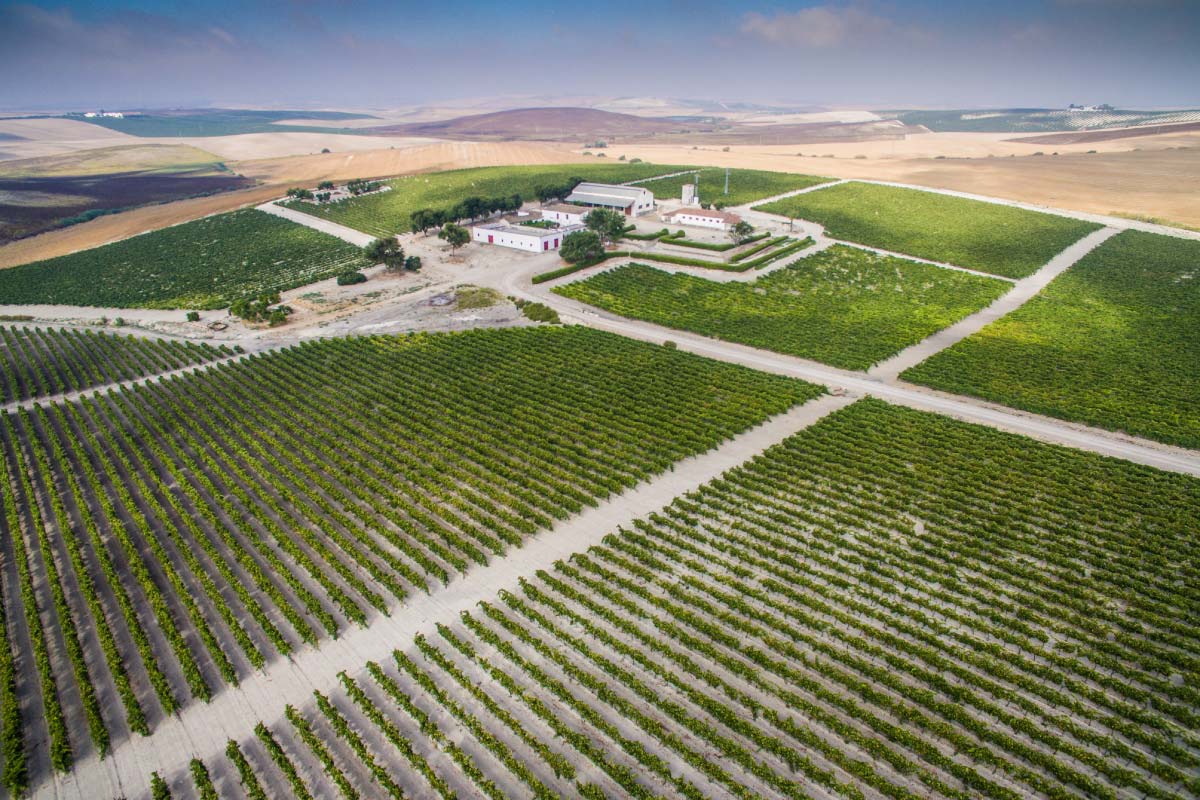The vine is a perennial plant whose annual journey from budburst to harvest drives every step of sherry viticulture. In the Jerez region, this cycle follows a solid and important pattern shaped by climate and tradition. The vine enters dormancy in winter, awakens in spring, flowers and sets fruit in early summer, ripens through veraison, and finally yields grapes for harvest. Each of these stages must be carefully managed – a timing critical to the flavor and quality of Jerez’s wines. In other words, understanding the vine life cycle in Jerez is fundamental: it is the foundation on which growers schedule pruning, rain-capture, canopy work and picking to produce the most expressive grapes possible.
THE VINE’S LIFE CYCLE THROUGHOUT THE YEAR
In the calcareous soils of the region (albariza soil), a mature vine lives around 30–35 years. Over that lifespan, its annual cycle repeats like clockwork. Throughout spring and summer the vines are cooled or heated by the two prevailing winds – the humid poniente from the west and the hot levante from the east – while the region’s 3,000+ hours of summer sunlight drive photosynthesis. Rainfall (about 600 mm per year) mostly falls in autumn and winter, and albariza soil acts like a sponge, soaking up winter rains to sustain the vines in the dry months. In short, Jerez’s warm sunny climate with mild winters shapes every palomino grape growth stage.
You can expand your knowledge about albariza and its role in the region here:
Vine development in Jerez can unfold in six stages: dormancy, weeping, budburst, flowering/fruit set, veraison, and harvest.
– Dormancy: In winter the vine is largely at rest.
– Weeping: Sap, rich in water, sugars, and mineral salts, drips from pruning cuts as the plant awakens from its winter dormancy.
– Budburst: Green buds explode into shoots and leaves.
– Flowering: By mid spring those shoots flower, yielding grape clusters that will swell through the hot days.
– Veraison: As summer approaches, veraison (the onset of ripening) turns the clusters soft, sweet and golden – a clear signal that harvest is approaching.
– Harvest: Finally, during mid-August harvest (vendimia) takes place. Grapes are only picked at their peak.
In Jerez, palomino grapes typically sprout in late March and reach ripeness by mid August. This annual cycle must be watched carefully because any delay or stress can throw off sugar levels, acidity and overall grape quality.
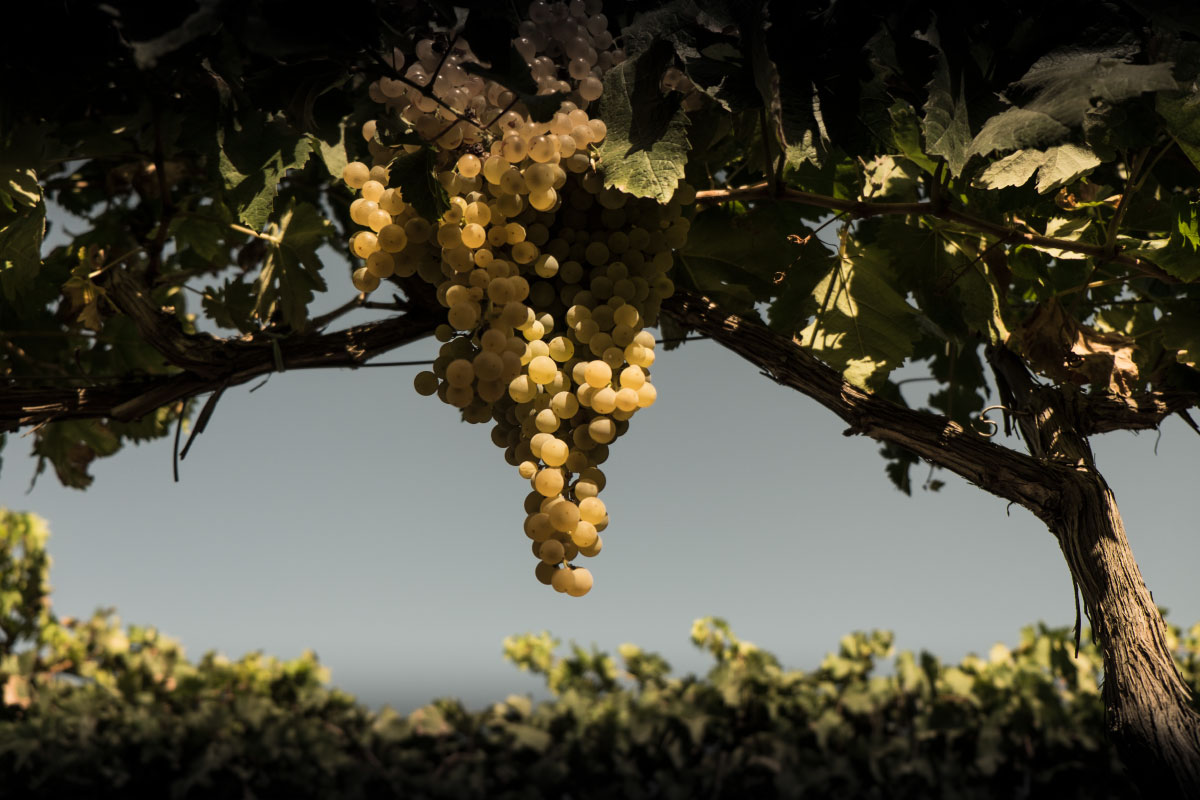
WHY UNDERSTANDING THE VINE’S CYCLE IS ESSENTIAL TO SHERRY PRODUCTION
In the region, timing is everything. The quality of sherry wine depends on grapes at just the right stage of maturity, which in turn depends on the vine’s biology and local conditions. For example, palomino’s early sprouting and summer harvest (around 11° Baumé) yield lean, moderate acidity must ideal for dry styles, while a later harvest can produce richer fruit for sweet styles, such as dulce styles. Growers must schedule work – pruning, canopy management, harvest – to match the vine’s development. In fact, Jerez’s vineyard work is choreographed by the vine’s cycle.
The result is a high level of control: by understanding when their vines bud, bloom and ripen, growers can foresee and influence the final wine style. For instance, harvesting at night – a growing trend – keeps palomino clusters cool, preserving their delicate flavors and balance. Getting these aspects right means the difference between the fresh acidity of a fino and the oxidized richness of an oloroso when going into the solera and criadera system.
THE SEASONAL STAGES OF THE VINE: A TIMELESS NATURAL RHYTHM
The vine’s cycle can almost be viewed as a story in four chapters, one for each season.
WINTER DORMANCY: THE VINE AT REST
During the cooler, rainy months the vine goes to a dormancy period, conserving energy and moisture. Leaves fall and sap retreats into the roots and trunk. In the region’s mild winters, hard frosts are rare – but growers still perform vital work.
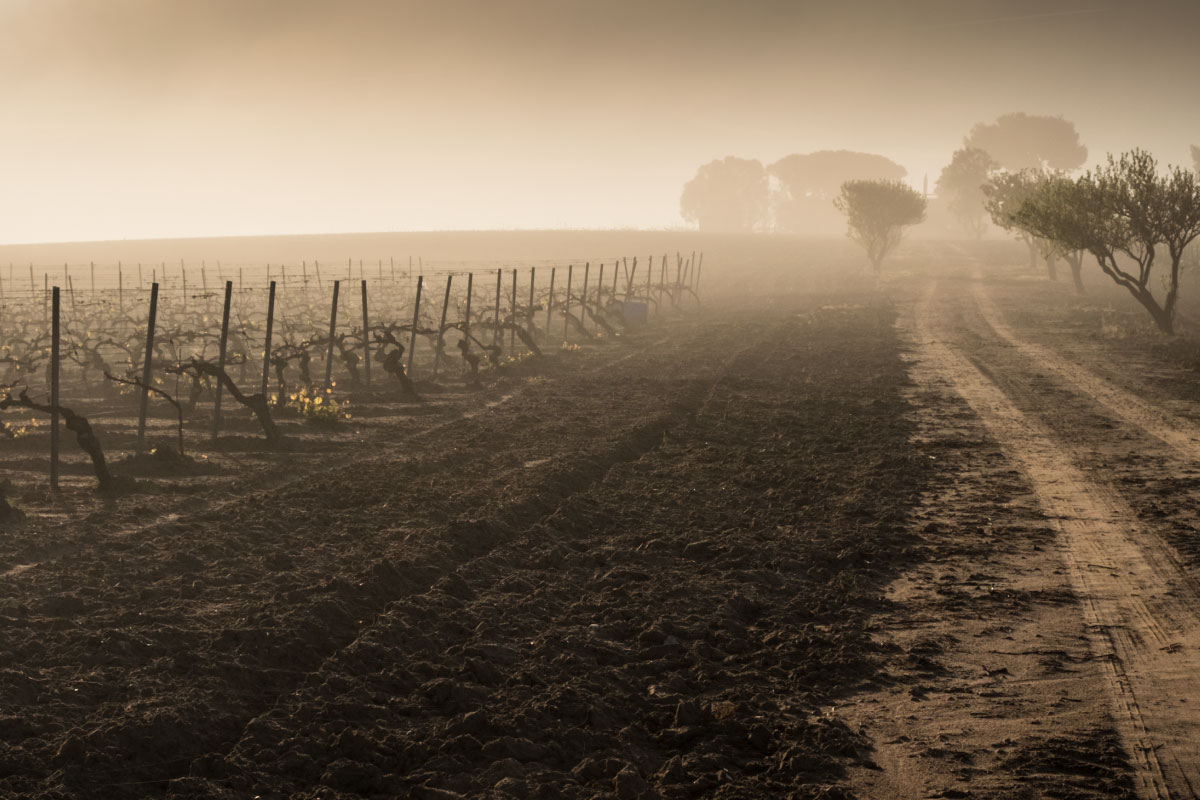
Winter pruning is the most important task, done after leaf-fall but before the rains. This annual pruning, usually in January–February, literally shapes the vine, fixing its bud count for the coming season and controlling next year’s yield
As sherry regulations cap production (around 80 hl/ha), this pruning is crucial to limit quantity and ensure quality. Meanwhile, on albariza hills the famous “aserpia” is done:
The Work in the Vineyard: Aserpia
In order to store water during the winter, “aserpia” (also known as “alumbra”), work very specific to this region, is carried out on the slopes of the albariza hillsides. After harvest, vineyard soil is banked up to form rectangular pools in which the autumn and winter rainwater can then be retained and stored, thus preventing it from running down the slopes and being lost at the bottom of the hills. During spring, the aserpia is also broken up and the soil is flattened by crumbling the albariza in order to seal the soil and thus avoid evaporation.
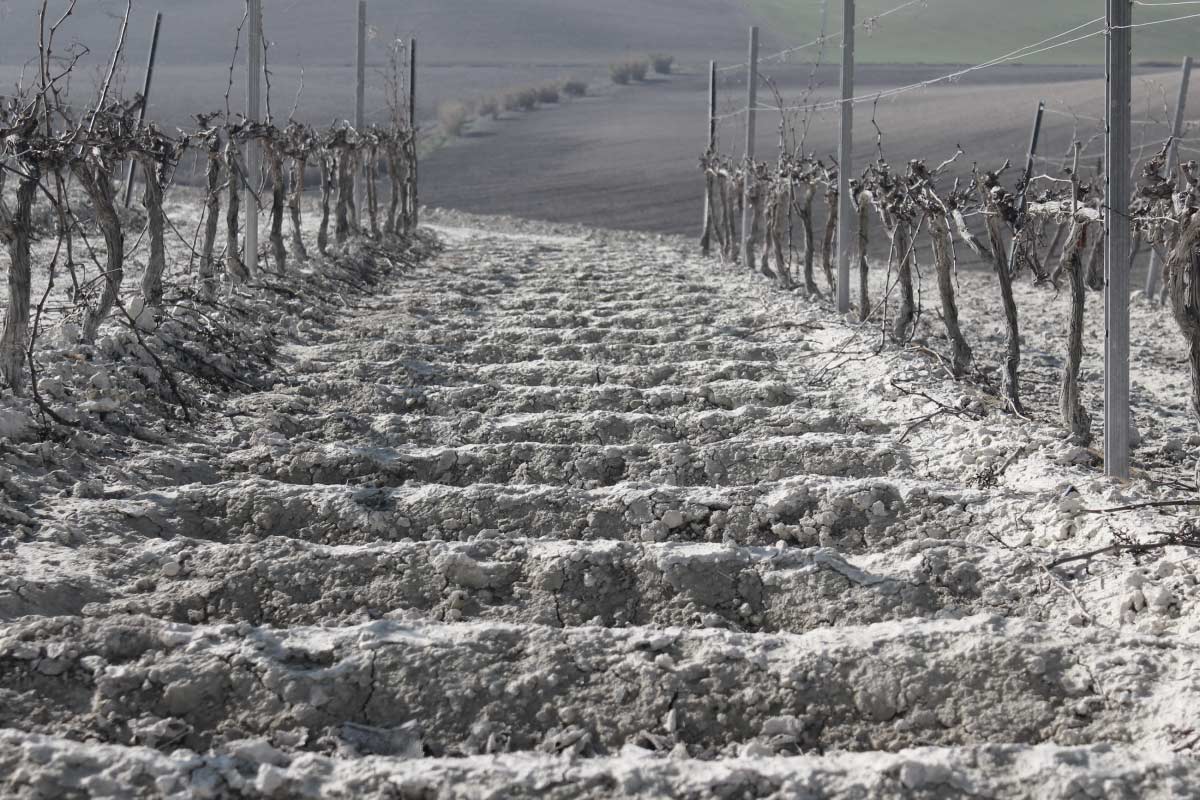
Winter dormancy is also when the vineyard is prepared – the roots are fed, water is stored, and the vines are hard-pruned into shape.
SPRING BUDBURST: THE BEGINNING OF GROWTH
With the return of warm, longer days, life returns to the vineyard. In Jerez the buds of palomino open up during March unleashing a flush of soft green shoots and leaves. This budburst signals the official start of the growing season. The vineyard comes alive: pruning scars sprout, new tendrils find the trellis, and the vine rapidly begins photosynthesizing.
Vineyard crews work to support this growth. One spring task is “castras”, light green pruning to remove excess shoots and suckers. By cutting away any stray growth, the vine focuses its energy on the main fruiting canes and avoids unnecessary competition.

Simultaneously, the soil is cleaned up. The aserpiado ridges from winter are removed and the topsoil is closed up (“allanar” in Spanish) to preserve moisture. Thanks to albariza geological nature its surface hardens, creating a dense “crust” preventing water and moisture from disappearing. Vines are tied up to the trellis wires so that the new shoot system is exposed to sun without tangling.
All this vineyard work in Jerez supports the spring surge: by budburst and flowering time, each vine has a firm structure and open canopy to bear fruit.
FLOWERING AND FRUIT SET
As spring progresses, the vine’s energy is devoted to flowering. In warm May–June Jerez, clusters of small, pale flowers emerge on the shoots, each flower a future grape. Pollination leads to fruit set, and tiny green berries begin to form in clusters. Summer is the growth season: leaves grow thick, the canopy expands, and grapes start swelling. The vineyard is often surprisingly green during these months thanks to the Poniente wind’s humidity.
Deepen in the most iconic region’s winds: poniente and levante with this article:
Growers continue to manage the canopy – lifting wires, trimming leaves if needed (recastra)– to ensure adequate sunlight and air flow. This helps the fruit ripen evenly and prevents diseases.
By early summer the first signs of grape color may appear. The clusters, still hard and green, are already showing the result of months of care: because of late winter pruning and recastras, each cluster should be compact, with good sun exposure. The nutrient flow from root to shoot is at its peak, preparing the grapes for veraison ahead.
VERAISON: THE RIPENING OF GRAPES
With July heat the magic happens: veraison. Grape berries suddenly soften, gain sweetness and develop their golden hue. Growers watch this step closely – when clusters turn soft and sweet, it means harvest is about to happen and daily control becomes critical. Vineyard work during veraison is minimal: mostly watching and monitoring evolution.
The weather becomes friend or foe now – very hot, dry days (sometimes enhanced from the persistent levante wind) help finish ripening and keep grapes disease-free. Depending on weather intensity, ripening will happen faster or slower affecting the harvest and final quality of grapes and global yields.
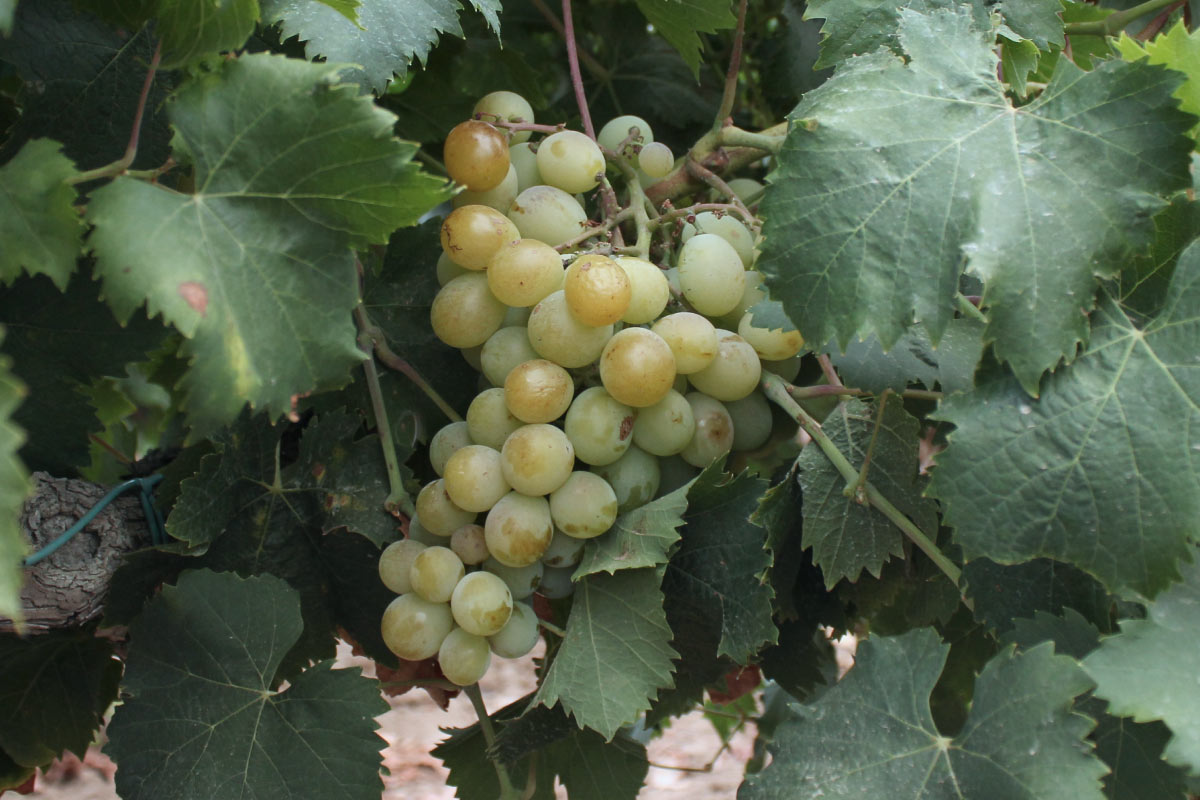
HARVEST: CULMINATION OF THE CYCLE
The vine’s annual cycle climaxes with the “vendimia”, the grape harvest. In Jerez this typically took place in late August or early September for palomino. However, recent harvests are starting to happen earlier (first week of August).
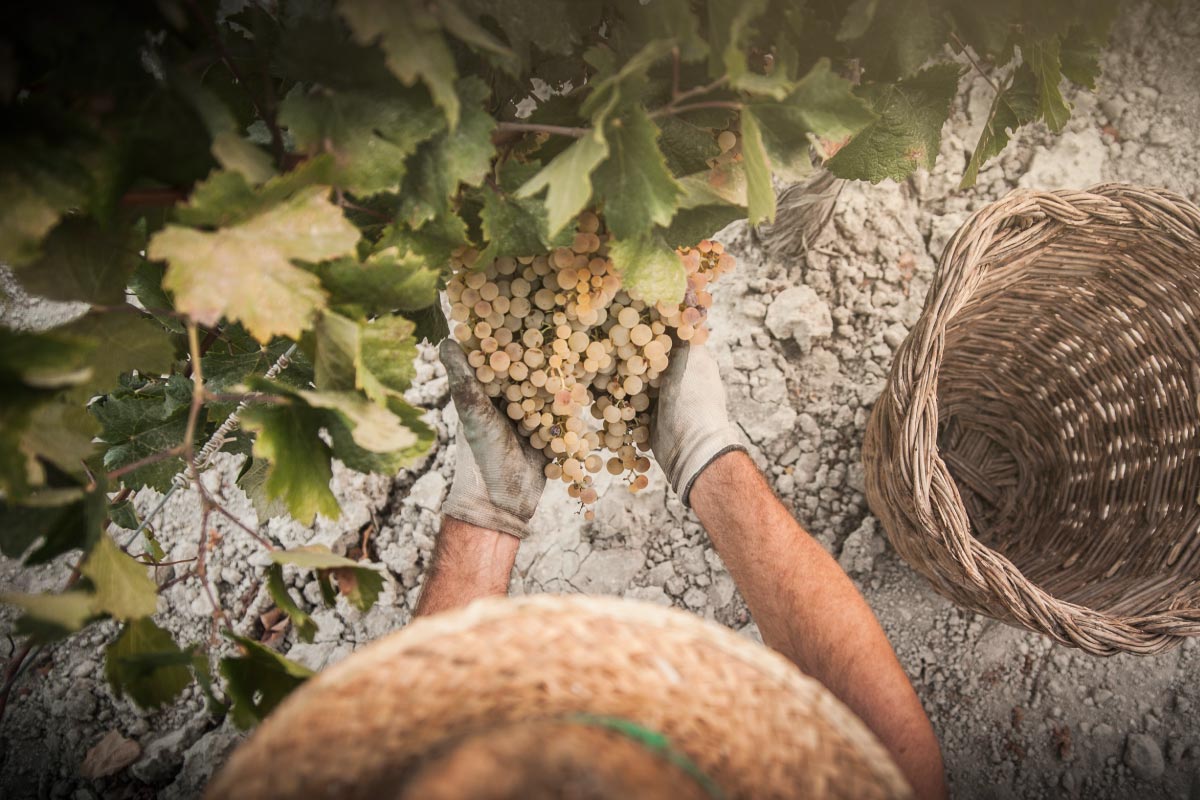
Harvest timing is decided vineyard by vineyard, depending on the pago, location and soil and climate conditions. For example, upland inland pagos like Montegilillo (at 76 m elevation) heat up faster and ripen earlier than low-lying coastal vineyards like Las Cruces (at 31 m). Growers will pick inland blocks first, then coastal blocks later.
On average, about half the harvest in Jerez is now done mechanically; the other half is still hand-picked. An increasingly common practice is night harvesting: picking grapes before dawn to keep them cool and avoid any unwanted spontaneous fermentation. Once harvested, the fruit is quickly pressed.
Get to know past harvests done by Lustau and its results:
In select vineyards, especially those of pedro ximénez and moscatel, the sherry vineyard cycle extends beyond the regular harvest. Grapes are left to over-ripen on the vine, concentrating sugars as the clusters bronze under the summer sun. This late harvest marks the prelude to Lustau’s unique moscatel style. Soleo process, on the other hand, goes beyond. Bunches are laid on straw mats to dry further under the Levante wind. Over several days, berries shrivel into raisins, yielding a syrupy, aromatic must.
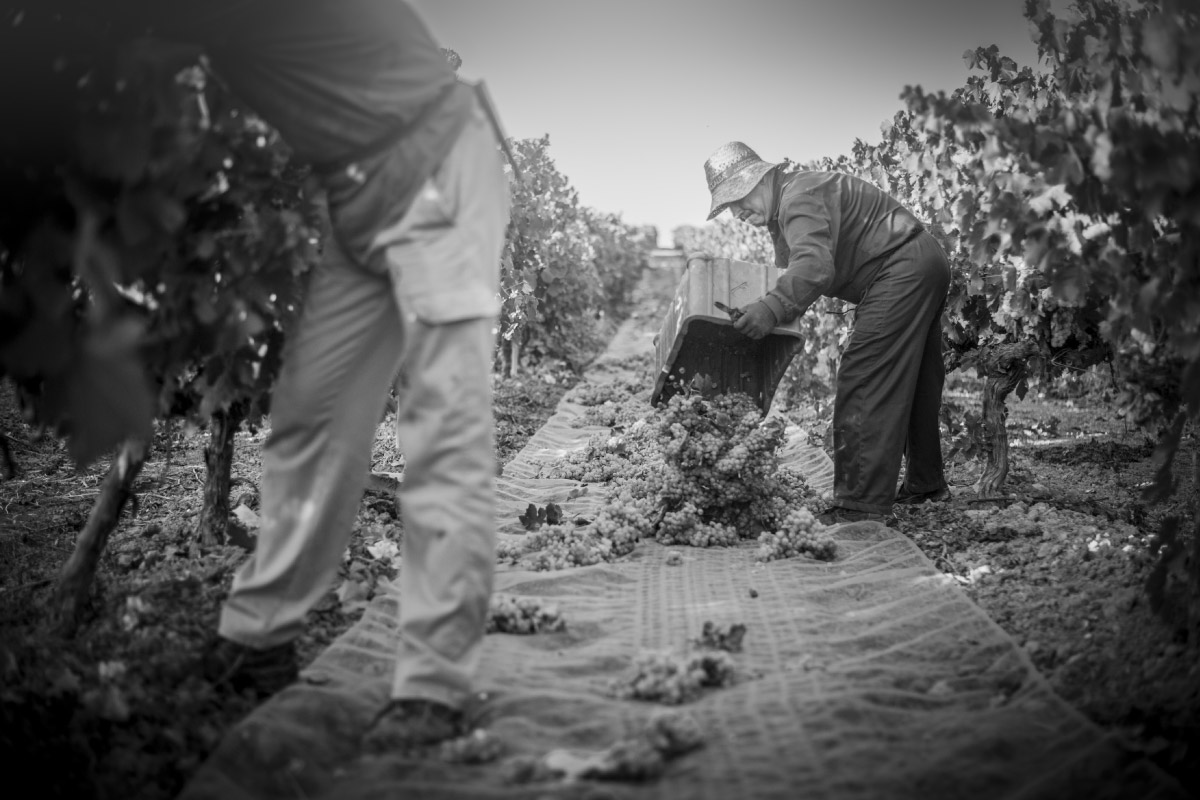
THE ROLE OF CLIMATE AND TERROIR IN THE VINE’S DEVELOPMENT
Jerez’s unique terroir – a combination of soil, sunlight, rainfall and wind – strongly guides the vine’s cycle.
The Influence of Albariza Soil
Most famous is the chalky, pale albariza soil: a soil formed from ancient seashells. Its most remarkable quality is moisture retention. Each winter it absorbs as much rain as it can (thanks to previously mentioned “aserpia”), acting like a giant reservoir for the dry, summer months. By summer, the soil bakes into a hard crust, which dramatically reduces evaporation and keeps the vine’s roots moist. Vines in albariza have been found with roots up to 12 m deep, tapping into these underground reserves. This means vines can survive long, hot summers (often with daytime temperatures above 40 °C) without irrigation, slowly drawing sustenance from the soil well.

Sunlight, Rainfall, and the Levante & Poniente Winds
Beyond soil, Jerez’s climate itself governs growth. With around 3000–3200 hours of sunshine per year, vines maximize photosynthesis. Summers are very hot and long, and winters are mild – rarely dropping below freezing. Average rainfall (~600 mm annually comes in autumn and winter, which conveniently recharges the soil right after the vines flower. Equally important are the winds: Poniente (western) and Levante (eastern) airflows. During the growing season, warm Levante breezes dry the vineyards, reducing mildew risk and accelerating ripening. The cool, moist Poniente, more common in autumn, can delay maturation (good for late-harvest and sweet-sherry grapes) and brings rain to fill the albariza reservoirs. In short, it’s the interplay of bright sun and wet winters – plus these characteristic winds – that makes vine life cycle Jerez so distinctive. Budburst and bloom happen under clear skies, grapes develop under dry heat, and the rainy season safely falls after harvest.
